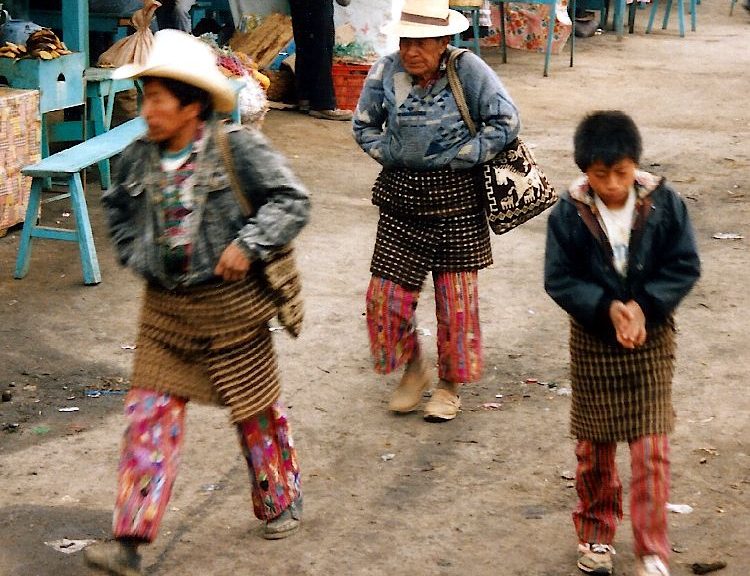
Banana republics
It was Wednesday 20th March and I’d spent just over a month travelling from Hawaii through the USA and Mexico and now I was walking along a dusty road into Guatemala. The first person I saw was a smiling man who was able to fleece me of my Mexican Pesos. Anyway, with a wad of cash I hopped on an old American school bus (common transport in Central America) and headed off.
Before I knew it the bus was packed just like in Asia and not Mexico. We passed some rather grotty villages and shanty towns with plastic rubbish everywhere. Arrived in Huehuetanango, according to the guidebook “a pleasant little hill town” but to me, more like your grotty Philippine town. I couldn’t find a hotel with a single room. Eventually settled on the 3rd one I found – Hotel Mary a double room for 40 Quetzals – clean room and bathroom. Tempted by a cold beer but they were quite expensive 6Q = US$1 =66p I need to sort out the currencies in my head. In the evening had a wander. No colourful locals just a usual grotty town. Stopped at restaurant and had a burger and chips. Surprisingly good (10Q) and a beer (6Q). On the way home spotted a cake shop and couldn’t resist.

The following day I got a local, decrepit bus to the main bus station and was quickly ushered on to another. There were plenty of interesting looking locals at the station including men with red embroidered trousers.


The bus had many upturned seats – “saved” so had to sit at the back. A blind lad came and sat next to me. He had a card round his neck not sure what it said. He seemed OK if rather dirty and with a snotty nose. Why was he getting on the bus on his own to a town 3hrs away? The bus filled quite quickly including some youngish lads, early twenties, drinking cans of beer which they threw out the window, they were also smoking. I hadn’t seen anyone smoking up to now. We drove up into the clouds and then down into Quetzaltenango. The day was warm and pleasant until a late afternoon storm. From the main station outside town I had to walk through a rough and tumble market with lots of colourful locals to a local bus stop and half an hour later I was in the town proper. I decided to go for one of the expensive hotels looking for comfort – the Hotel Rio Azul. But then I checked out another hotel (Horiani) which was much cheaper at 18Q/US$3 for a decent sized, clean room with window and what looked like an OK shower (it was still only cold).
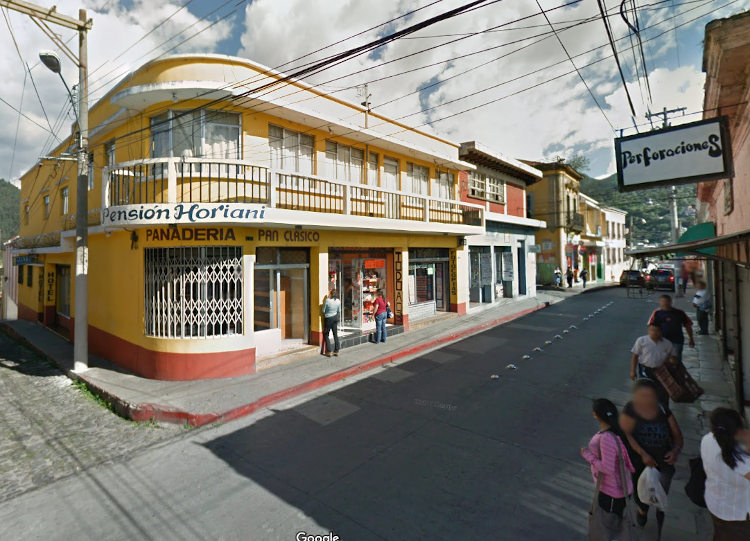
I didn’t sleep that well so had a lie in but then got the bus for the short hop to San Francisco el alto . It’s a small hilltop town just 17kms away. Most days it’s very sleepy but on Friday it comes alive to become a huge market. Mainly animals – pigs, turkeys and dogs but also plenty of other things and of course lots of colourful locals. It’s also not as touristy as the more famous Chichicastenango which is heavy on handicrafts and tourists.








Back in town that night I sat in the plaza just to soak up some atmosphere. This bloke sat next to me. At first he was quiet, than he started asking me rather personal questions and eventually asked me if I wanted to come for a shower with him!! Well that was a first, Central America or not. Perhaps he knew a hot shower would be rather tempting. But not that tempting.
Instead, I splashed out at Pizza Ricca for a giant burger and beer 12Q + 7Q.
The following day I was up and out early. Town wasn’t open but the breakfast stalls at the bus station were. I had a lump of pork, beans and rice and a very weak coffee. From here I got a bus to Solola and then another to my final destination Lago de Atitlan. The short trip from Sololo descends quite steeply through a pine forest and soon I could see the blue waters of the lake guarded by two huge volcanoes. The town on the lake is officially Panajachel, but it is nicknamed Gringotenango due to the large number of foreign tourists. I had already met a few on my trip that day including a German guy who sat next to me. The road from the bus stop to the shores of the lake was lined with stalls selling ethnic clothes, bags, masks, tablecloths, interspersed with hotel signs and cafes.

According to the Lonely Planet all the hospedajes (family run pensions) charged about $5. Prices obviously were going up getting ready for Semana Santa as I had to pay $8 but it did have a bath (cold water of course) with a little balcony which was lovely. I’d arrived fairly early so that gave me a bit of time to explore. I also couldn’t resist buying a few pressies for family and friends back home. Later I unpacked at the hotel and washed my socks and undies. At five-ish I ended up by the shore listening to the gentle waves and a two man band at a nearby bar. It was very peaceful and relaxing and I couldn’t think of another place I would rather be.
Then a couple of sellers approached me. Business must have been poor as they hung around for ages despite my refusals to buy anything. However they had the last laugh as eventually I relented and bought a tablecloth for my mum.


The following morning I had breakfast at the hotel and chatted with some of the tourists. A couple were British studying American and Latin American Studies spending three months in Guatemala. They were also off to Honduras and then Nicaragua. Tough life! They were off with a bunch of others to the Chichi market. I decided to stay here and get a boat trip across the lake.
I got to the lake at nine am. It was perfect, a lone fisherman in his dugout canoe, not a ripple on the surface of the lake, a blue sky, just a few wisps of cloud circling the summits of the volcanoes. I spent a pleasurable hour on the roof of the ferry across the lake with a Scottish bloke. He was a teacher back home but was planning on packing it in to go travelling.
On the other side, at the village of Santiago de Atitlan, there were lots of colourful locals in a pretty big and chaotic market. I also arrived at the church square just as the congregation were pouring out. They were all wearing their Sunday best which meant the men wore long black and white striped shorts and cowboy hats.


While there I was accosted by some locals and led to the house of a local Mayan shaman where the idol Maximón was being kept that year. He is moved each year to a new location in town and is one of the more bizarre manifestations of traditional Mayan beliefs adapted to Christianity — he’s considered a saint. He receives offerings of cigars and cigarettes, liquor, flowers and cash. He is fond of scarves and cowboy hats and can be photographed for a small fee. Rather than pay the fee I have just stolen someone else’s photo from here. The Maximon I saw though was actually smoking a cigar as well!
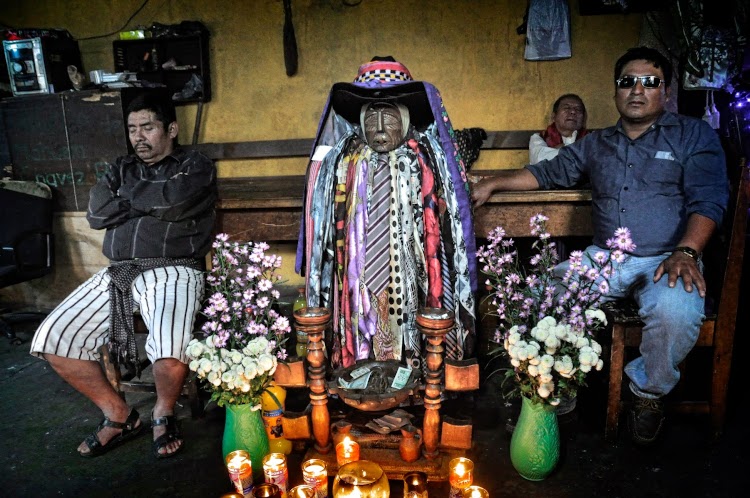

I stayed on the other side of the lake for quite a few hours. It was interesting to watch the people washing in the lake and also some women collecting water in big urns and of course young lads diving off a makeshift jetty.
That night I actually had a hot shower! I celebrated with a cold beer in the restaurant with guacamole and a burger.
The following morning I counted a few more bites on my legs. I think they were mossies rather than bedbugs but you can’t be sure. Anyway, I got a bone shaker of a bus that was packed to the gunnels and then another arriving not too much later in Antigua Guatemala the ancient capital.
I was starving so entered the mercado in search of food and found the comedor corazon de Jesus (Jesus’ heart cafe!) for a pork chop, beans, rice and bread for 10Q. And then I found a posada near the station for a bargain basement price of 22Q (bed bugs free of charge) with no window in the room but a nice little courtyard with a few caged birds and a non caged parrot. Strangely enough I wasn’t overly impressed with Antigua – I thought it very much like an earthquake-hit ruined Spanish colonial city and a poorer cousin to many in Mexico and I guess that’s what it was.


Supplemental – Dangers!
Although I haven’t felt in any danger at all it seems talking to tourists that they have all heard some horror stories – rapes at the Montebello lakes and two guys shot in Panajachel resisting a mugger only last week and the list goes on. My diary noted that it was not as bad as Scotland, as that week marked the Dunblane shooting where 16 schoolkids were shot dead.
I left Antigua the following day in another boneshaker of a chicken bus into the new capital Guatemala city. Mainly to pop into the Poste Restante to collect any mail. That just shows how time flies – I used to tell my family where I was going and they could post letters for me to pick up. No internet in those days!

I was going to stay but had a quick change of heart and caught the bus to Chiquimula near the border with Honduras. From here I got a minibus and was soon bumping along a dirt track to the border two and a half hours later. There were just two immigration buildings separated by a football pitch. I paid the guy on the Guatemalan side 10 Q to stamp my passport with the exit stamp then walked across the football pitch to the Honduran side where I paid the Honduran guy (wearing a string vest) 30L (Lempira is the Honduran currency) for their stamp.

On the other side of the border there were pickup trucks waiting to transport us to the nearest town and our destination: Copan Ruinas. It’s a small town set in dry rolling hillsides and by a small stream. I found a cheap hotel and had a welcome cold shower as I was filthy from my trip. I decided to splash out at the best restaurant in town- it was pretty cheap at 40 L (at the border I got 10.6L/$1 – I notice in July 2020 it’s 25L/$1). My diary notes that I thought I would like Honduras (despite its reputation as a dangerous place) but it doesn’t say why!
The following morning I loaded up with a big breakfast – omelette, french toast, bacon, toast and jam and then headed to the ruins. The Lonely Planet talks about the “spectacular Mayan ruins at Copán“. My diary says – “Not really too much to see, they’ve only restored the smaller buildings and are still excavating the tunnels. Quite a nice setting though, dry tropical jungle and not many tourists.”



Town was pretty soporific in the afternoon so I walked up the hill to the ruins of an old jail, then had a siesta. Later had a wander round the trinket shops and met up with a few travellers. Found out there was a boat from Panama to Colombia – note taken.
The following day (28th March) off again. Got four buses over the day and eventually arrived in Tela with a new travelling buddy – Bernie from St Helens. It was quite a nice rundown Caribbean town and we checked into The Boarding House Sara for 50L for a double (It was a big old house by the beach on the corner of Avenida 8 and Calle 11 – but I see it no longer exists – certainly as a guesthouse). Had a wander around town – it’s hot!
Bumped into a few travellers we had met along the way. Everyone is pretty much going in the same direction and the towns are small so I tended to bump into the same people from time to time. As the sun set went for my first dip in the Caribbean – I noted the sand was grey but the water cool and refreshing. We went for a few beers that night but I noted that town was rather dead despite the noise from the discos. Maybe we were just too early? I was later to find out, especially in Colombia, people only head out after midnight!
The following day we went for a walk along the beach to a Garafuna village and had a swim. I noted that I didn’t know where LP got it’s info about them. “The villages are right on the coast with white sand beaches, simple houses shaded by coconut palms with tiny restaurants serving delicious food. A place to spend idyllic days” – The beaches were all grey with plenty of washed up garbage and the villages consisted of dirty shacks strung haphazardly along the beach. I had one of the “delicious” specialities. It turned out to be a conch soup. The meat was a mixture between squid and tripe and the consistency of an elastic band served in a coconut sauce soup.

It was interesting that all along the coast here were many black people (rather than mainly Hispanics inland) and they spoke a very odd form of English. Apparently the English were in control of the coast for a period of time and they were responsible for transporting slaves from Africa, some of whom eventually ended up here.
I then got a bus to La Ceiba. I don’t think I stayed but I noted I liked the place – “an interesting shady square with crocodiles and terrapins and an interesting run down market” but yet again I was really feeling the heat. It was stifling. My next destination was a short flight away – Utila Island. The “airports” on either side were just dirt strip runways. On the island, I collected my bag and just walked along a path into the main town. Utila is tiny and there are no roads – just narrow concrete paths.


I thought Utila was a really quirky sort of island, almost a throwback to pirate days. There were quite a few drunken old white guys around but also God-fearing black 7th day Adventists – all mixed up speaking an indecipherable English in a Caribbean dialect. The biggest industry is tourism and diving in particular. There is nothing else not even fishing. I booked into a cheap hotel called Selly’s. It wasn’t too bad but along with huge numbers of sandflies (I was covered in bites not long after I arrived) but also I saw tarantulas and scorpions wandering around the place.

I stayed on Utila for quite a few days, enjoying the island life – I was tempted to say beach life but there are few beaches on the island itself although I did quite a bit of snorkelling and also took a boat out to Water Cay which was spectacular – both above and below the water line. It was also strange to see all the places had English names – Thompson’s Bakery, Blueberry Hill, Seabreeze Pub, Sharkey’s and the unforgettable Bucket of Blood Bar. Talking about Thompson’s Bakery, it was like a lot of the places – very ramshackle, seemingly banged together with various bits of wood and corrugated tin. One day I was having coffee and cake there and started speaking to an old guy. He had a bit of an Irish accent and he said his grandfather had arrived there in 1860 and he’d never left. Bizarre.
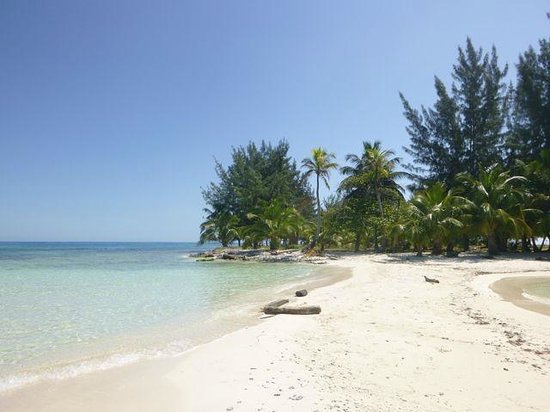
I was later to find out about the actual history of the place and it is fascinating (from wikipedia):
..Later on, English, French, and Dutch pirates established settlements on the islands and raided the Spanish cargo vessels laden with gold and other treasures from the New World. The Welsh buccaneer Henry Morgan established his base at Port Royal on Roatán, about 30 kilometers from Utila, in the mid-17th century; at that time as many as 5,000 pirates were living on that island.
Colonization by the Spanish began in the early 16th century. Over the next century, the Spanish plundered the island for its slave trade and eliminated the island of its natives by the early 17th century. Britain, in its aggressive attempt to out-colonize the Spanish in the Caribbean, occupied the Bay Islands on and off between 1550 and 1700. During this time, the buccaneers found the vacated, mostly unprotected islands a haven for safe harbour and transport. Utila is rich in pirate lore, and even presently, scuba divers look for sunken treasure from Captain Morgan’s lost booty from his raid on Panama in 1671.
The British were forced to give the Bay Islands to the Honduran government in the mid 19th century. It was at this time that the nearly uninhabited islands were being populated by its now Caymanian roots. They remain rich in Caymanian culture and dialect.
Utila has been a part of Honduras for approximately 150 years. For nearly 200 years Spanish conquistadores and British pirates battled for control of these islands, ignoring the native people for the most part. During this period, the Islands were used for food and wood supplies, safe harbour, and slave trading. Remains of British forts and towns named after famous pirates remain as their legacy.
Making a significant impact on Utila’s cultural base were the Black Caribs, who originated as the Callinagu in the Orinoco Delta in Brazil. Migrating north to the Lower Antilles the Callinagu subsequently exterminated the Arahuaco men, but kept and bred with their women creating a new ethic subgroup that became known as the Caliponan, or Yellow Caribs. In 1635 African slaves who had been shipwrecked by their own devices began to marry the Caliponan women, adopting their language and culture so as to assimilate locally and thwart their owners attempts to retrieve them. Thus the Garifuna society was born.
On 12 April 1797, a total of 2,248 Garifunas were sent to Honduras and the Bay Islands in an attempt by the English to restrain the Garifuna from assisting the French in the English/French dispute over the islands of Martinica, and Santa Lucia. Scattered on the north coast of Honduras and in the Bay Islands, the Garifuna still populate much of the Bay Islands, maintaining their own cultural identity and language. On Roatan the Garifuna maintain a strong presence in the Sandy Bay community, on the western most side of East Harbor, a number of them having made the journey to Utila from Cayo Chachahuate, a small nearby island that is a bastion of the Bay Island’s Garifuna.

Soon my time was up. My next destination was the small town of Limon on the Mosquito coast. I’m not sure why I went there – it’s not even mentioned in my Lonely Planet. I think because it is the furthest East you can go in Honduras on the bus, from here it is the jungle of the Mosquito coast. However I thought it was pretty good. It seemed much nicer than the Garifuna villages further west, cleaner and that included the white sand beaches. I got a room in Hospejade Martinez and met a Spaniard and Italian who were already there. And they were in fact looking for someone to take them deep into the Mosquitia.
Later that evening they invited me to a little gathering on the beach with some locals. We had a fire and had a few beers. I stayed there a couple of days. It didn’t take me long to realise that the few restaurants that were there only served one thing: fried chicken, chips and salad. I say chips but they are actually plantains – fried bananas. However, one night there was a special on – fish! It was pretty tasty and they also had some pretty good music on – like reggae but a bit faster. I noted that the people here were jet black and everyone wears T shirts with American sports teams on them. I saw Atlanta Braves, San Francisco 49ers and Chicago Bears amongst others.



I stayed in Limon a few days – it was much more chilled than Utila of course – well I say chilled – it was still boiling and no respite from the insects. Once the sand flies went to bed the mosquitos came out! But I still spent a few pleasant hours swinging in a hammock enjoying the sea breezes and reading. I noted that one night it was Viernes Santa (Good Friday) so I was expecting a big night. It started well – I managed to find BBQ Bistek with plantano chips and cabbage. I was starting to believe cabbage was the national dish of Honduras. There was a bit of music and a few people partying but all low key.
The next day I was headed to the capital Tegucigalpa but to get there I needed an overnight stop in La Ceiba. I was expecting the place to be packed with holidaymakers and nowhere to stay. However, I got off at an empty bus station and all the shops were closed. I even managed to get a room in the first hotel I tried – the Royal. Not a bad room – very old and run down but big but with a bathroom in a similarly shocking state but plenty of (cold) water – just as well as town was baking (of course). I went for a wander down the beach and this is where everyone was – like Blackpool on a bank holiday. Everyone was drinking beer and soft drinks but throwing all their empties and plastic cartons on the beach – don’t worry the sea will wash it away (and bring it back tomorrow). I stopped at a beach restaurant and smacked my chops when I saw the menu – spaghetti and meatballs and other exotic dishes. However, “No hay”. It was back to Pollo, cabbage, frijoles and tortillas – welcome back old friends.

The following day was time for another interminable bus journey – eight hours to Tegucigalpa (Tegus). It could have been a shorter trip but the driver was the slowest in the world. A bit odd as I have found bus drivers in developing world to be hell drivers. This guy didn’t even overtake on blind corners. I noted that we did stop for lunch at Lago de Yojoa – very pretty and there was a row of comedors selling fried fish with pickled cabbage.
In Tegus I checked into my chosen hotel – the Ritz although it had changed its name to Kostasula. It was excellent with a very pleasant rooftop terrace. The room was spotless and there was free water and coffee. The city looked pretty small and run down for a national capital – the hillside slums were pretty close to my hotel but it was in the more run down Comayaguela area of town. That night I went to a Chinese restaurant – apparently quite common in Tegus and had a huge plate of chow mein special. I also had a haircut as my first glimpse in a mirror for weeks wasn’t that pretty. I was in town for a day or two but I wasn’t impressed. Town was very quiet as it was still holiday time, and stripped of life the buildings were a bit grim – the bare bones of the city seemed to have been picked clean by the ubiquitous vultures circling the sky and patrolling the river in large numbers. I did get some washing done and bought some fruit from the market and made myself avocado sandwiches for lunch.


I was soon off again. Taxi to the bus station and then off to Danli where I got a connecting bus to El Paraiso. Here I joined up with an American, Josh, and we got a share taxi to the border. It cost me $2 for an entry stamp to Nicaragua but for Josh it was an extra $5. He asked, “Why do I pay so much?”. “Because you are American” came the incredulous answer! We waited for a bus for quite some time on the other side and were joined by Karsten, a Dane. It was another hour to Ocotal – 4 Cordobas (another new currency to get used to) and then two hours standing in a packed bus to Esteli. We arrived at dusk. We could see plenty of buildings with bullet holes. Apparently there was much fighting here in 1987 during the revolution.
I decided to stay another day in Esteli and used it to go to the Salta Estanzuela waterfall. It was a bit of a struggle. I kept having to ask directions and it was all uphill. It was quite nice but a lot of rubbish left behind presumably from the Semana Santa crowds. It was good to dip my feet in the cool waters though and have them nibbled by the small fish. I also think I saw a quetzal, but I can’t be sure.
Wed 10th April. Off to Granada. A nice town. Very Spanish in style – buildings with adobe walls, wide streets but very quiet. I found a good hospedaje – a converted villa. You entered into a large living room which opened onto a large courtyard and covered patio with tables and chairs. The rooms are a more recent addition to the house and have rather flimsy walls but the ambience of the patio made it worthwhile (30C). I went off exploring the town. The local taxis are all horse drawn and the local market was interesting with a wide selection of food bubbling away in cauldrons – makes a change. Changed money – 8 Cordobas to $1 (in 2020 it’s 34!). It’s a bit of a strange place Nicaragua – there don’t seem to be any street names and they greet each other with “adios”.

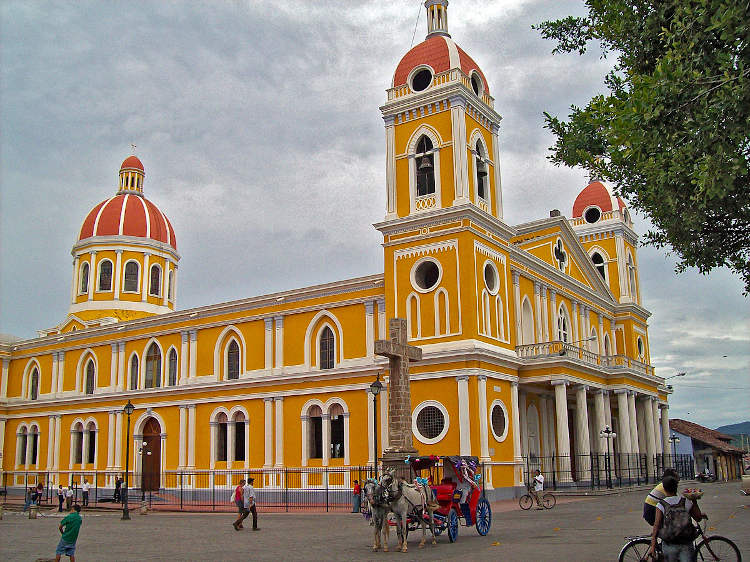


That evening I had a takeaway beer and shared my streetside pollo frito in the central park with a stray dog. I also went to the cinema to see Richard Gere in Internal affairs. There was me, two locals and a couple of tourists. On the way back to the hotel it was getting dark but still warm. People were sitting outside their houses in rocking chairs. All the windows and doors were wide open trying to get any breeze.
The following day I took a bus to the capital Managua. It wasn’t that far but by 9am it was already getting hot. Downtown Managua was ghostly. The only building intact after the earthquake in 1972 was the cathedral. The ruins were still standing but without its roof. The area surrounding had been flattened and was deserted.
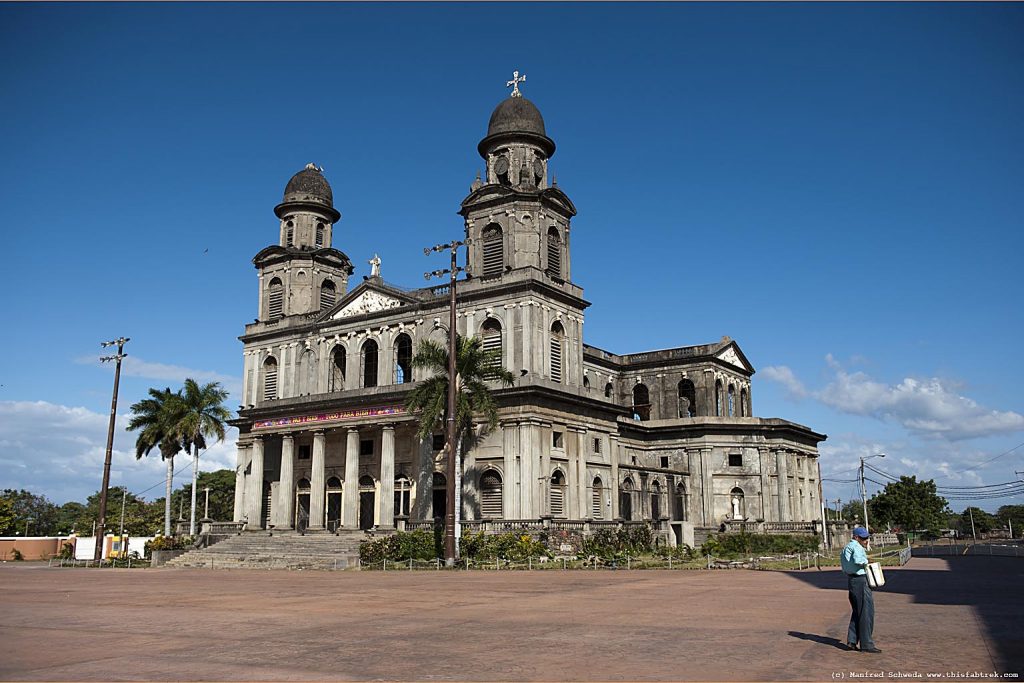

It was strange being in the middle of a city of 1 million and only half a dozen people about including me and a gaseosas vendor. I chatted to him for a bit. He was Argentinian, lives in LA, married to a Nicaraguan and he said he was there for the upcoming election in October. Work that one out. I wandered down to the lakeside. There were a few more people around. It was quite pleasant as there were stalls, seats and a view to the volcanoes across the lake – they were the symbol of the city and the country but I have to say I wasn’t overly impressed – they just looked like four small hills (there are actually five as the symbol). They are actually just the remnants of Volcano Chiltepe on the other side of the lake. The water was a distinct brown colour and very unpleasant.
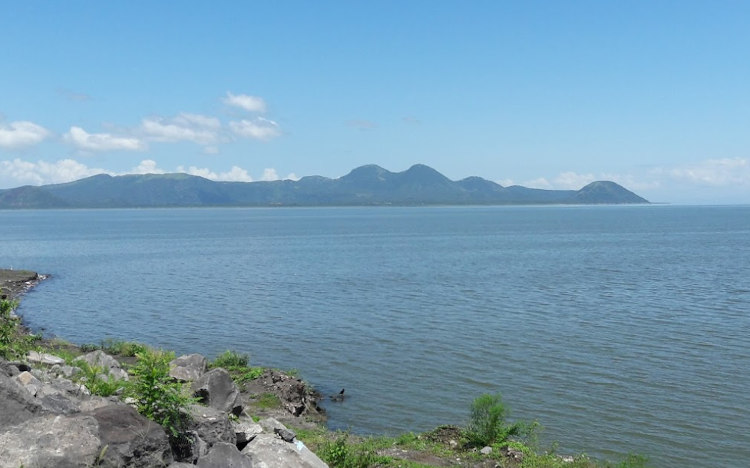
Later, I got on a bus to Masaya. By the bus station was a huge mercado and mercado artesanato so I bought quite a few pressies for family and friends. the locals didn’t haggle but the prices were so low anyway. Had a healthy lunch of avocados, rock melons and oranges and ate them in the park.

Wandered through town to lake view. Town was pretty dead – hot and siesta time. Quite an impressive and pretty lake but the water didn’t look enticing – a horrid green colour – volcano Masaya didn’t look very high but the sea of black lava reminded me of my tough old day in Mexico – that didn’t look high either!
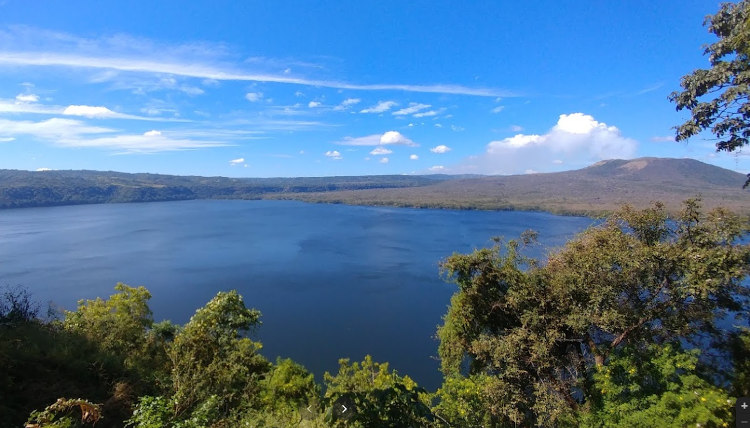
That night back in Granada, I wandered to the street stall of the previous evening and shared the same chicken dinner with a different stray dog and watched the sky go red then black behind the cathedral. In the dark it was still and very hot and humid. It reminded me of Asia and my thoughts drifted to what I was going to do after this trip – teaching English in China?

Friday 12th April. Up very early for the trek to the border. I got a bus to Rivas at 6.30 and then another packed one from there to the border. In contrast to the relaxed nature of previous border crossings there was a bit of a rigmarole on the Nicaraguan side involving a number of offices and having to pay for the exit stamp in US dollars and having to change Cordobas at a ridiculous rate. Then there was another bus across the border zone and then 100m walk to Costa Rica. Here there was a long wait in line to pay 75 Colons for an entry stamp (US40c). ($1=585 Colons 2020) Having arrived at the Nicaraguan border at 9.15, here I was at 10.45 and there wasn’t a bus until 12.30. Anyway, I got that bus, a couple more, including a flat tyre in one before arriving rather bedraggled at Tilaran at 6.30. Checked into a cheapie hotel for $4 and had a welcome cold shower. That night found a very nice little cafe and had a tasty casado con carne salsa (beans, rice, meat, cabbage) and a great cup of coffee.
Another early morning. Up at 5.30 and a filling brekko of beans, rice, egg and coffee. This time getting the bus to Fortuna to see Volcan Arenal. the countryside round here was very like New Zealand – very green, rolling hills and lakes, low clouds and rather damp.

We arrived in Fortuna to find the hotel I was planning on staying in had burnt down 6 months previously. I did find an old lady who rented rooms at $5 and that was fine. The volcano dominates the town but it was obscured by cloud. There is enough in town to keep you occupied for ten minutes so I decided to go on a short tour to the volcano anyway. It went via the hot springs which were OK but because of the low cloud we couldn’t see any lava which was supposed to be visible at the time. We could very clearly hear the volcano rumbling under our feet though which was slightly unnerving.
Here is the photo I missed: credit to naturalworldsafaris.com
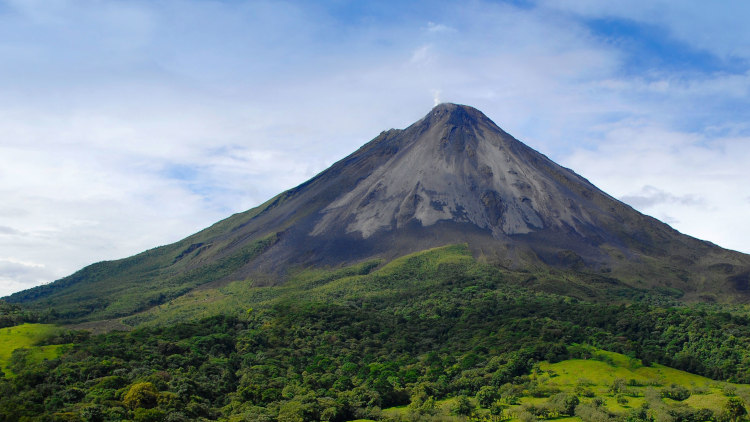
The following day off to the capital San Jose. I looked at two cheap hotels but the rooms were dodgy looking boxes with cardboard walls and some very dodgy looking people wandering about outside. I did find a place which was much cleaner and safe looking. I had a wander around town and I must say it was all rather run down and not the flash, clean, bright Costa Rica I had already got used to. An English girl actually came up to me in the street warning me that it was a dangerous place as did other travellers which didn’t give me much confidence. My diary doesn’t note me going anywhere of note and soon I was off again.



This time I was headed back to the Caribbean coast and another town called Limon. Here I found another scruffy hotel with a rough cardboard box of a room but it had a small balcony, was clean and a shower. I quite liked Limon though. These Caribbean towns have a bit of atmosphere, old wooden buildings with verandas.



In the middle of town was a small park (Vargas park) with very tall palms. It also had a population of three-toed sloths which was amazing. And they were very slow and relatively tame so easy to take photos.



That evening had the usual chicken and rice meal and had a beer in a sleezy looking bar (of which there many). The bartender told me he used to live in Tampa, Florida but had to leave America in a hurry as he had shot two guys. He seemed friendly enough with me though. The guidebook told me to stick to the main well-lit streets at night and watch out for pickpockets during the day.
Later in the day I took a bus to Moin which is the local port and I found someone to take me to the Tortuguera National Park. I handed him $25 and he told me to come back the following day. Hmm seems rather gullible of me but sure enough he was there the following day as planned. We were joined by a couple of Germans and then had a short stop while he repaired the boat(!) and then filled up with petrol. We left at 10.30 just as the rain started. The trip was pretty good though – very jungly and we saw loads of egrets, a couple of herons, crocodiles, turtles, pelicans, toucans and howler monkeys which we could hear all the time. That night I stayed in a cabina. I presume it was in Tortuguera village next to the beach. I noted that the jungle was really thick here and the mossies were not unexpectedly tenacious. I also noted the place was quite pricey (for me and for the times) $12 for bed, breakfast and evening meal (which was fish, rice and beans unsurprisingly). That night I paid a guide to take me up the beach and we saw a couple of huge leatherback turtles which was amazing. I also nearly stepped on a huge rat-like creature – I think it was an agouti.




The following day I was up early at 5.45 for a stroll along the beach. Saw some turtle tracks and heard howler monkeys over the crash of the waves. Stopping at the dock it would have been perfect, however, soon enough there was the buzz, buzz of the boats. It much be hell in the tourist season. Fortunately, however, one was for me to take me back to Limon and civilisation.



Soon enough I was off again, new day, new country, this time I got the bus to Sixaloa. along the way I saw acres and acres of banana plantations, and hence banana republic. We picked up a lot of foreigners in Cahuita and also Puerto Viego (I was thinking of stopping there but warned off by the Germans in Limon as it was “nothing special” – However from the bus it seemed quite nice – palm fringed beaches and decent places to stay. I counted 16 foreigners on the bus – the most I had seen together on the entire trip. At the end a few got off, so I counted who was left: Me and Doug a laid back American who lives between New York and Puerto Viego, two Hungarians, a Canadian girl, An older Dutch guy and the two perennial Germans I had been bumping into for a while.
The actual border was a river and the crossing an old and rickety ex-railway bridge. On the other side – Panama!








